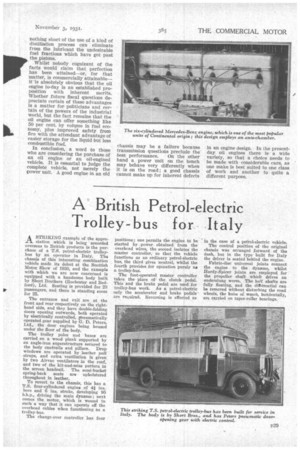A British Petrol-electric Trolley-bus for Italy
Page 115

If you've noticed an error in this article please click here to report it so we can fix it.
A STRIKING example of the appre
ciation which is being accorded overseas to British products is the purchase of a T.S. petrol-electric trolleybus by an operator in Italy. Tho chassis of :this interesting combination vehicle made its debut at the Scottish Motor Show of 1930, and the example with which we are now conderned is equipped with a handsome body built by Short Brothers (Rochester and Bedford), Ltd. Seating is provided for 23 passengers, and there is standing room for 25.
The entrance and exit are at the front and rear respectively on the righthand side, and they have double-folding doors opening outwards both operated by electrically controlled, rheumatically operated gear supplied by G. D. Peters, Ltd., the door engines being housed under the floor of the body.
The trolley poles and bases are carried on a wood plank supported by an angle-iron superstructure secured to the body cantraiLs and pillars. Drop windows are operated by leather pull straps, and extra ventilation is given by two Airvac ventilators in the roof, and two of the hit-and-miss pattern in the screen headrail. The semi-bucket spring, back seats are upholstered throughout in leather.
To revert to the chassis, this has a T.S. four-cylindered engine of 41 ins. bore and 6 ins, stroke, developing 95 b.h.p., driving the main dynamo; next comes the motor, which is wound in such a way that it can operate off the overhead cables when functioning as a trolley-bus.
The change-over controller has four
positions; one permits the engine to be started by power obtained from the overhead wires, the second isolates the master controller, so that the vehicle functions as an ordinary petrol-electric bus' the third• gives neutral, whilst the fourth provides for operation purely aa a trolley-bus.
The foot-operated master controller takes the place of the clutch pedal. This and the brake pedal are used for trolley-bus work. As a petrol-electric only the accelerator and brake pedals are required. Reversing is effected as
in the case of a petrol-electric vehicle.
The control position of the original chassis was arranged forward of the dash, but in the type built for Italy the driver is seated behind the engine.
Fabric-disc universal joints connect the engine to the dynamo, whilst Hardy-Spicer joints are employed for the propeller shaft which drives an underslung worm. The half shafts are fully floating, and the differential can be removed without disturbing the road wheels, the hubs of much, incidentally, are carried on taper-roller bearings.








































































































































































































































